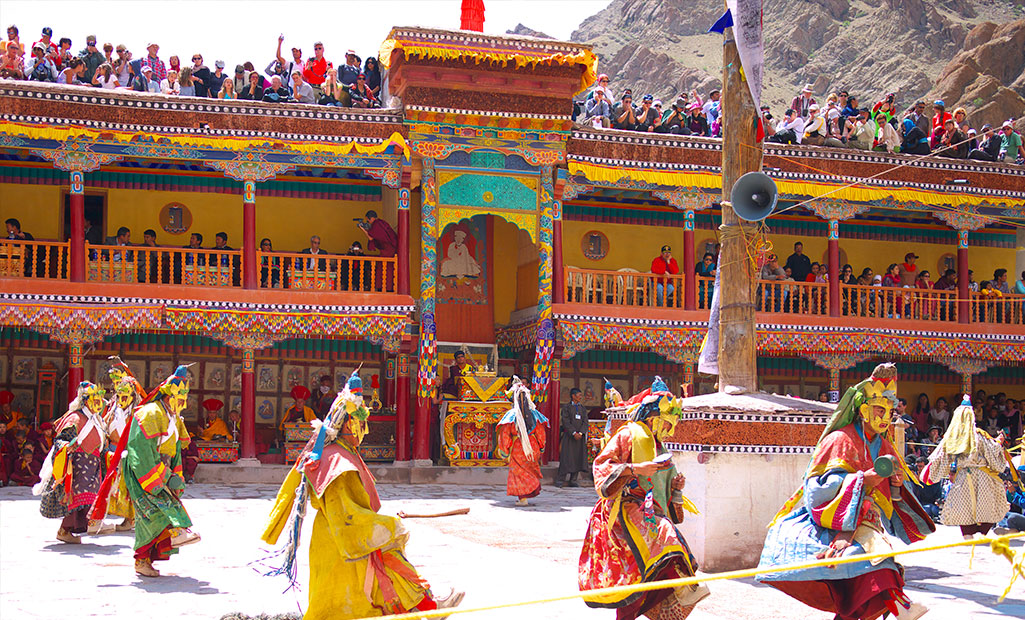Ladakh also known as little Tibet is a desert land with few natural resources and an extreme climate. This region experiences a minimum temperature of – 30 degrees in winters and 35 degrees in summer. Snowfall extends the winters for longer duration destroying crops, closing roads to Ladakh for 6 months in an year making access to the area very difficult. Areas with high snowfall causes floods wherein areas with low snowfall faces water and food shortages.
Leh is one of the highest cities in the world. The climate change has impacted Ladakh as snowfall and weather conditions have become erratic and unpredictable. The narrow Hindukush corridor and narrow Indus river cleaves the territory of Ladakh. The region of Ladakh acted as the nexus point between South Asia and Central Asia when silk route was being utilized.
Key Learning
Culture & Tradition
Geography
History
Biodiversity
Trip Snapshot
Explore Leh local market, Leh Palace and Shanti Stupa, a symbol of peace built by Japanese monks to promote world peace. Witness the unique history, sociology and cultural tradition, a living example of Tibetan Buddhism. A heritage trip across Ladakh brings learning about history and multicultural roots.
Study Buddhist traditions and Culture, art and folklore through visit to prominent monasteries of Ladakh. Attend morning prayers at Thiksey monastery, interact with monks, students and explore the museum. The Shey palace and shrine are excellent example of Tibetan Architecture. Taste the Tibetan food at the café of Thiksey Monastery.
Explore your culture study further at Hemis Monastery, a 17th century monastery of the Drukpa lineage. The extensive museum at monastery retains precious religious treasures, skull vessels, swords and tiger skins. Explore the atmospheric upper and rear shrines. The monastery has striking resemblance to the architecture of Potala of Tibet.
Enrich knowledge of Ladakhi culture, tradition, influence of Tibetan culture and lifestyle, visit two enchanting monasteries of Lamayuru and Alchi that will bring you closer to another face of Tibetan culture and tradition. Visit to the village will enhance your understanding of Ladakhi houses, life, and agriculture practices. The wonderful restaurant of Lamayuru monastery serves delicious Tibetan food.
Saspol Caves are the group of caves located above Saspol, near the ruins of an old fort are referred to as Pentad of Saspol. Experience the pull of magnetic effect at Magnetic hill, visit PatharSahab Gurudwara and most important witness the mighty Indus river confluence with Zanaskar river and Biodiversity around the river.
Visit Pangong Tso lake to understand geographical features of endorheic basin and wetland. These closed hydrologic systems form large saline lakes or inland sea, such as Caspian Sea.
Cross the second highest motorable road in the world passes through Chang La, a high mountain pass of Ladakh. The air is very rarified and armed forces canteen provides refreshments at the pass. The area is inhabited by nomadic tribes of the region known as Chang-pa, understand their life, culture and traditions.
Reflect back on the learning and sharing your knowledge with the other groups under the guidance of an expert on Ladakh. All students will be given participation certificate and best team presentation will win badge of honour.
Trip Essentials Duration: 6 Days Grade: 7th STD to 12th STD Starting point: Leh End point: Leh Free Teacher: on every 15 paying participants Minimum group size: 15 Maximum group size: 60 Participation Fee on request Transport from school premises to school premises will be provided on request.
For detailed itinerary and planning of trip feel free to connect with us, We would be happy to plan the logistics and trip as per your requirements and group size.

